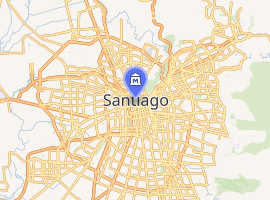Museo Chileno de Arte Precolombino
The Museo Chileno de Arte Precolombino (English: Chilean Museum of Pre-Columbian Art) is an art museum dedicated to the study and display of pre-Columbian artworks and artifacts from Central and South America.[1] The museum is located in the city centre of Santiago, the capital of Chile. The museum was founded by the Chilean architect and antiquities collector Sergio Larraín García-Moreno, who had sought premises for the display and preservation of his private collection of pre-Columbian artefacts acquired over the course of nearly fifty years. With the support of Santiago's municipal government at the time, García-Moreno secured the building and established the museum's curatorial institution. The museum first opened in December 1981 and was closed from 2011 to 2013 for renovation.[2]
 Museum logo | |

| |
| Established | December 1981 |
|---|---|
| Location | Bandera 361 Santiago, Chile |
| Type | archaeology, anthropology pre-Columbian art museum |
| Director | Carlos Aldunate del Solar |
| Curator | José Berenguer Rodríguez |
| Public transit access | Metro station: |
| Website | www.precolombino.cl |
Building
The museum is housed in the Palacio de la Real Aduana that was constructed between 1805 and 1807.[3] It is located a block west of the Plaza de Armas and close to the Palacio de los Tribunales de Justicia de Santiago and the Former National Congress Building.
Collection


Items in the museum's collections are drawn from the major pre-Columbian culture areas of Mesoamerica, Intermediate / Isthmo-Colombian, Pan-Caribbean, Amazonia and the Andean. The museum has over 3,000 pieces representing almost 100 different groups of people. The collection ranges from about 10,000 years. The original collection was acquired based on the aesthetic quality of the objects, instead of their scientific or historical context. The collection is broken up into four areas:[1]
- Area mesoamerica
- Includes a statue of Xipe Totec, an incense burner from the Teotihucan culture, and a Mayan bas-relief.[1]
- Area Intermedia
- Showcase pieces include pottery from the Valdivia people, and Capuli figures chewing coca leaf. Gold objects from the Veraguas and Diquis cultures are also represented.[1]
- Area Andes Centrales
- Features masks and copper figures, of which many were confiscated from graves. Examples include those from the Moche and textiles. The oldest textile in the museum is in this area, a painted cloth almost 3,000 years old from the Chavín culture.[1]
- Area Andes del Sur
- This collection features modern Chilean and Argentinian pieces. Ceramic urns from the Aguada culture, snuff trays from the San Pedro culture, and an Incan quipu.[1]
References
- Andrew Benson; Melissa Graham (3 August 2009). The Rough Guide to Chile. Penguin. p. 91. ISBN 978-1-4053-8381-3.
- "Museo de Arte Precolombino reabrirá sus puertas en noviembre". La Tercera (in Spanish). 1 August 2013. Retrieved 17 October 2013.
- "Palacio Viejo de los Tribunales o Antiguo Palacio de la Aduana" (in Spanish). National Monuments Council. Archived from the original on 19 October 2013. Retrieved 17 October 2013.
Further reading
- Solis, Felipe (1994). "La Costa del Golfo: el arte del centro de Veracruz y del mundo huasteco". In María Luisa Sabau García (ed.). México en el mundo de las colecciones de arte: Mesoamerica, vol. 1 (in Spanish). Beatriz de la Fuente (Mesoamerican research coordinator), María Olga Sáenz González (project coordinator). México, D.F.: Secretaría de Relaciones Exteriores, Instituto de Investigaciones Estéticas-UNAM, and Consejo Nacional para la Cultura y las Artes. pp. 183–241. ISBN 968-6963-36-7. OCLC 33194574.
External links
| Wikimedia Commons has media related to Chilean Museum of Pre-Columbian Art. |
- Museo Chileno de Arte Precolombino, official website (in Spanish and English)